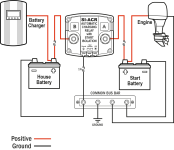Seaduced629
Recruit
- Joined
- Feb 6, 2022
- Messages
- 4
I'm doing a "deck off" renovation of a Bass Buggy pontoon boat. It has a 1979, 90 hp Mercury on it. I want to add a second "house" battery system and charge both the start and house systems from the Merc. We intend to sleep on the boat for several days at a time and I hate to paddle.
The rectifier output is on a red wire, tied to the starter cable under the cowl. So, it can't be isolated from the battery, unless I cut it and then rig a way to exit the cowl. But on this motor, there is an unused white wire in the harness. I'm thinking, I can take the red wire off of the rectifier and tie it back. Then attach the white wire to the rectifier and the other end to the charge isolator at the electrical panel.
I'll have to tie the ignition switch end of the red wire back (since it is now a dead wire) and run a wire from the start circuit fuse block to the red (battery) wire on the ignition switch. Otherwise, I could connect the two batteries through an 18 gauge wire. Definite fire hazard.
So far, my concern is the current rating of the motor-to-boat harness connector. I'm working on getting the info from the manufacture.
What am I missing? Any thoughts?
The rectifier output is on a red wire, tied to the starter cable under the cowl. So, it can't be isolated from the battery, unless I cut it and then rig a way to exit the cowl. But on this motor, there is an unused white wire in the harness. I'm thinking, I can take the red wire off of the rectifier and tie it back. Then attach the white wire to the rectifier and the other end to the charge isolator at the electrical panel.
I'll have to tie the ignition switch end of the red wire back (since it is now a dead wire) and run a wire from the start circuit fuse block to the red (battery) wire on the ignition switch. Otherwise, I could connect the two batteries through an 18 gauge wire. Definite fire hazard.
So far, my concern is the current rating of the motor-to-boat harness connector. I'm working on getting the info from the manufacture.
What am I missing? Any thoughts?




















